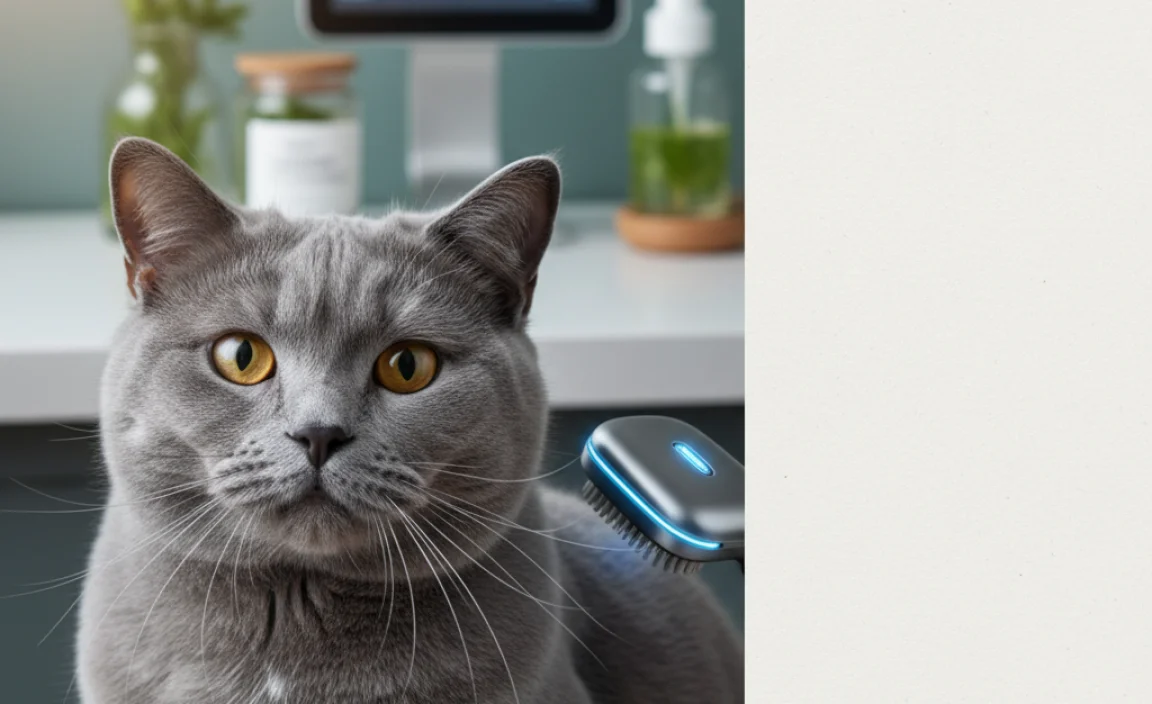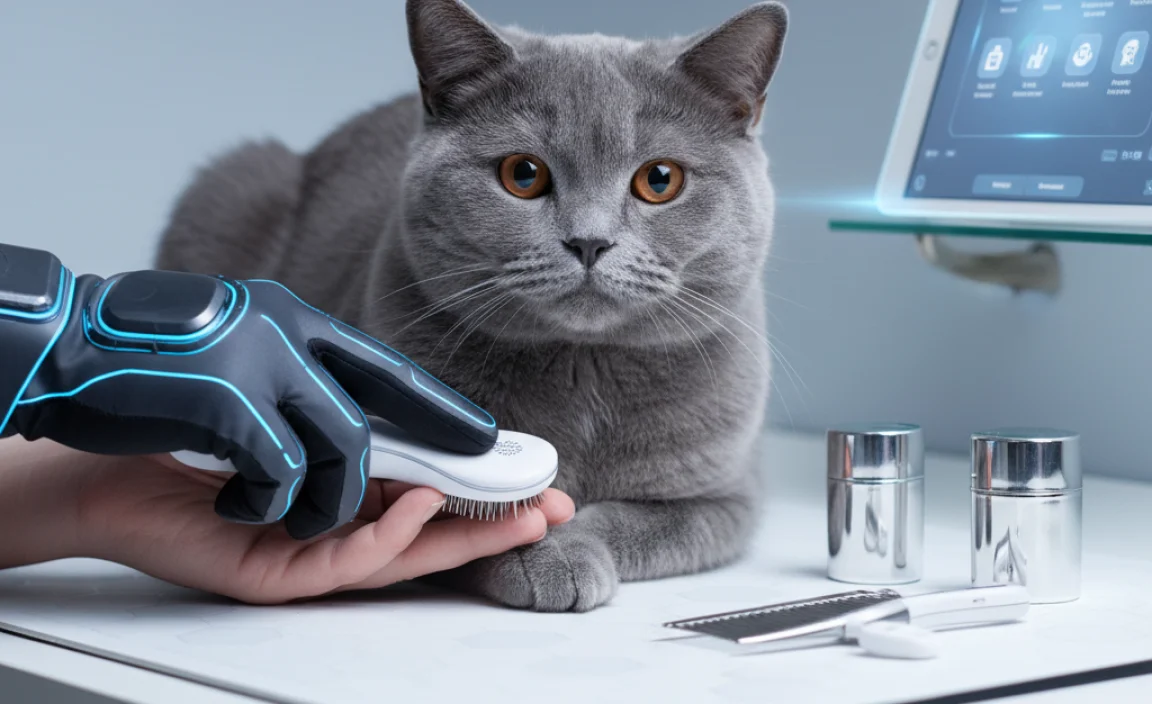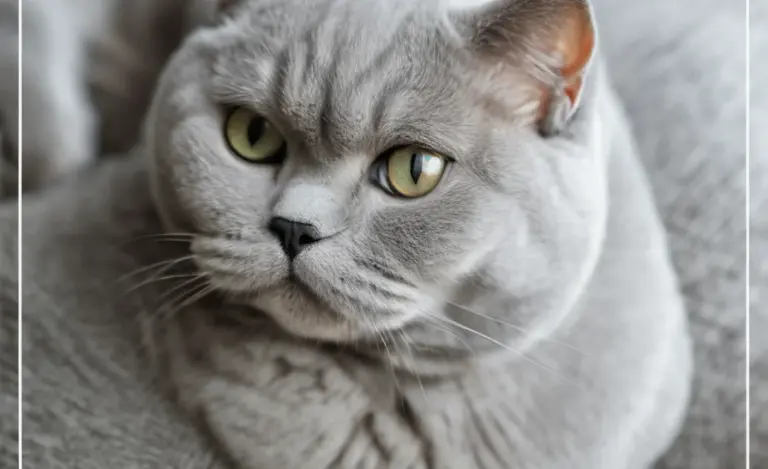Preventive Grooming Innovations: The Smart Secret?
Quick Summary: Preventive grooming is key to keeping your British Shorthair healthy and happy. Regular brushing prevents mats and hairballs, nail trimming protects furniture, and dental care avoids costly vet visits. Early introduction to these routines makes grooming stress-free for both you and your feline friend. Innovative tools like self-grooming stations and enzymatic toothpaste can make the process even easier!
Bringing a British Shorthair into your home means embracing their thick, plush coat and charming personality. But with that beautiful fur comes the responsibility of regular grooming. Many owners find the idea of brushing, nail trimming, and teeth cleaning daunting. The good news is that with the right approach and some innovative tools, preventive grooming can become a bonding experience rather than a battle. Let’s explore how to make grooming a breeze, ensuring a healthier and happier life for your beloved British Shorthair.
We’ll cover essential grooming practices and how to introduce them gently. Plus, we’ll explore new tools that can simplify your routine and keep your cat looking and feeling their best. Get ready to unlock the secrets to stress-free grooming!
Why Preventive Grooming Matters for British Shorthairs

British Shorthairs are known for their dense, plush coats. While gorgeous, this fur requires regular attention to prevent matting, hairballs, and skin issues. Neglecting grooming can lead to:
- Painful Mats: Matted fur pulls on the skin, causing discomfort and potential infections.
- Hairballs: Ingested hair during self-grooming can form hairballs, leading to vomiting and digestive issues.
- Dental Disease: Untreated plaque and tartar can cause gum disease, tooth loss, and even affect organ health.
- Hidden Skin Problems: A neglected coat can hide underlying skin conditions like allergies or parasites.
Preventive grooming addresses these issues proactively, saving you money and stress in the long run. A well-groomed cat is a healthier, happier cat!
Essential Grooming Practices for Your British Shorthair

Here’s a breakdown of the core grooming tasks every British Shorthair owner should master:
Brushing: The Foundation of a Healthy Coat
Regular brushing is the cornerstone of British Shorthair grooming. Aim for at least 2-3 times a week, increasing to daily during shedding season (spring and fall).
Tools You’ll Need:
- Slicker Brush: Removes loose fur and helps detangle.
- Metal Comb: Reaches deeper into the coat to prevent mats.
- Grooming Glove: A gentle option for cats who dislike brushes.
Brushing Technique:
- Start with the slicker brush, gently removing loose fur from the topcoat.
- Use the metal comb to work through the undercoat, paying attention to areas prone to matting (behind the ears, under the legs).
- Finish with a grooming glove for a gentle massage and to collect any remaining loose hair.
Nail Trimming: Protecting Your Furniture (and You!)
Trimming your cat’s nails every 2-3 weeks prevents them from becoming overgrown, sharp, and potentially damaging to your furniture (and your skin!).
Tools You’ll Need:
- Cat Nail Clippers: Guillotine-style or scissor-style clippers designed for small claws.
- Styptic Powder: To stop bleeding if you accidentally cut the quick (the pink part of the nail containing blood vessels and nerves).
Trimming Technique:
- Hold your cat gently but firmly.
- Extend one paw and gently press on the toe pad to expose the claws.
- Identify the quick (the pink area). Cut only the clear tip of the nail, avoiding the quick.
- If you accidentally cut the quick, apply styptic powder to stop the bleeding.
Important Note: If you’re nervous about trimming your cat’s nails, ask your vet or a professional groomer for a demonstration.
Dental Care: Preventing Painful Problems
Dental disease is incredibly common in cats, affecting up to 70% of cats by age 3, according to Cornell Feline Health Center. Regular dental care can prevent painful problems and expensive vet bills.
Tools You’ll Need:
- Cat Toothbrush: A small, soft-bristled toothbrush designed for cats.
- Cat Toothpaste: Never use human toothpaste, as it contains ingredients toxic to cats. Choose an enzymatic toothpaste specifically formulated for felines.
Brushing Technique:
- Introduce the toothpaste gradually by letting your cat lick it off your finger.
- Once they’re comfortable with the taste, gently rub the toothpaste onto their teeth and gums with your finger.
- Gradually introduce the toothbrush, starting with a few teeth at a time.
- Focus on the outer surfaces of the teeth, as this is where plaque tends to accumulate.
Aim to brush your cat’s teeth daily, or at least 2-3 times a week.
Ear Cleaning: Keeping Infections at Bay
British Shorthairs can be prone to earwax buildup, which can lead to infections. Check their ears weekly and clean them as needed.
Tools You’ll Need:
- Ear Cleaning Solution: Specifically formulated for cats.
- Cotton Balls: For gentle cleaning.
Cleaning Technique:
- Gently lift your cat’s ear flap.
- Apply a small amount of ear cleaning solution into the ear canal.
- Massage the base of the ear for a few seconds.
- Allow your cat to shake their head.
- Wipe away any excess solution and debris with a cotton ball.
Important Note: Never use cotton swabs (Q-tips) to clean your cat’s ears, as they can push debris further into the ear canal and damage the eardrum.
Preventive Grooming Innovations: Making Life Easier

Here are some innovative grooming tools and techniques that can make preventive care easier and more enjoyable for both you and your cat:
Self-Grooming Stations: A Cat’s Best Friend
Self-grooming stations are mounted brushes that cats can rub against to groom themselves. These are especially helpful for cats who enjoy being brushed but don’t always cooperate with human groomers.
Benefits:
- Encourages independent grooming.
- Helps remove loose fur.
- Provides a source of enrichment and entertainment.
Waterless Shampoo: Quick and Easy Cleaning
Waterless shampoos are a great option for spot cleaning or for cats who dislike baths. Simply apply the shampoo to your cat’s coat, massage it in, and towel dry.
Benefits:
- Convenient for quick cleanups.
- Reduces stress for cats who dislike water.
- Can be used to target specific areas of dirt or odor.
Enzymatic Toothpaste: Fighting Plaque Naturally
Enzymatic toothpastes contain enzymes that help break down plaque and tartar, making dental care more effective. Many cats also find the taste more appealing than traditional toothpaste.
Benefits:
- More effective plaque control.
- Improved taste for better compliance.
- Helps prevent dental disease.
Grooming Wipes: On-the-Go Cleanliness
Grooming wipes are pre-moistened cloths that can be used to wipe down your cat’s coat, paws, and face. They’re perfect for travel or for quick cleanups between brushings.
Benefits:
- Convenient for travel.
- Great for cleaning paws after outdoor adventures.
- Can be used to freshen up your cat’s coat.
Introducing Grooming to Your British Shorthair: A Gentle Approach

The key to successful grooming is to start early and introduce each practice gradually and positively. Here’s a step-by-step guide:
- Start Young: Ideally, begin grooming your British Shorthair kitten as soon as you bring them home.
- Create Positive Associations: Pair grooming with treats, praise, and playtime.
- Keep Sessions Short: Start with just a few minutes of grooming at a time, gradually increasing the duration as your cat becomes more comfortable.
- Be Patient: Don’t force your cat to do anything they’re not comfortable with. If they resist, stop and try again later.
- End on a Positive Note: Always finish grooming sessions with a treat or playtime to reinforce the positive association.
Troubleshooting Common Grooming Challenges

Even with the best approach, you may encounter some resistance from your British Shorthair. Here are some common challenges and how to address them:
| Challenge | Solution |
|---|---|
| Cat Hates Brushing | Try different types of brushes (slicker, comb, glove). Offer treats during brushing. Start with short sessions and gradually increase the duration. |
| Cat Resists Nail Trimming | Trim nails when your cat is relaxed or sleepy. Wrap your cat in a towel to limit movement. Only trim a few nails at a time. |
| Cat Refuses Toothbrushing | Start by letting your cat lick toothpaste off your finger. Gradually introduce the toothbrush. Make sure the toothbrush is soft and the toothpaste is palatable. |
| Cat Scared of Grooming Tools | Leave grooming tools out for your cat to investigate. Rub the tools on your cat without actually grooming them. Pair the tools with treats and praise. |
The Long-Term Benefits of Preventive Grooming
Investing time and effort in preventive grooming offers numerous long-term benefits for both you and your British Shorthair:
- Improved Health: Regular grooming helps prevent skin problems, dental disease, and hairballs.
- Stronger Bond: Grooming provides an opportunity to bond with your cat and strengthen your relationship.
- Early Detection of Problems: Grooming allows you to regularly check your cat for any lumps, bumps, or other abnormalities.
- Reduced Vet Bills: Preventive grooming can help avoid costly vet visits for preventable health problems.
- Happier Cat: A well-groomed cat is a comfortable, confident, and happy cat.
Choosing the Right Grooming Products
With so many grooming products on the market, it can be overwhelming to choose the right ones for your British Shorthair. Here are some tips:
- Read Labels Carefully: Choose products specifically formulated for cats. Avoid products containing harsh chemicals or fragrances.
- Consider Your Cat’s Needs: If your cat has sensitive skin, look for hypoallergenic products. If your cat is prone to hairballs, choose a shampoo and diet formulated to reduce hairball formation.
- Ask Your Vet: Your veterinarian can recommend specific grooming products based on your cat’s individual needs and health conditions.
- Start with the Basics: Focus on essential tools like a good brush, nail clippers, and cat toothpaste before investing in more specialized products.
- Check Online Reviews: Before purchasing any grooming product, read online reviews from other cat owners to see what they recommend.
Integrating Grooming into Your Routine
Making grooming a regular part of your routine is essential for its success. Here’s how to seamlessly integrate it into your daily or weekly schedule:
- Set a Schedule: Choose specific days and times for grooming sessions. Consistency helps your cat get used to the routine.
- Make it a Ritual: Create a calming and predictable environment for grooming. Play soft music, dim the lights, and speak in a soothing voice.
- Combine with Other Activities: Incorporate grooming into playtime or cuddle sessions. For example, brush your cat while they’re purring on your lap.
- Be Flexible: If your cat is having an off day, don’t force them to be groomed. Adjust your schedule as needed.
- Track Progress: Keep a grooming log to track when you brushed, trimmed nails, and cleaned ears. This helps you stay on schedule and monitor your cat’s coat and skin health.
Understanding British Shorthair Coat Types
British Shorthairs have a unique coat that requires specific care. Here’s what you need to know:
- Dense and Plush: Their coat is thick and dense, with a plush texture. This requires regular brushing to prevent matting.
- Double Coat: They have both a topcoat and an undercoat. The undercoat is prone to shedding, especially during seasonal changes.
- Prone to Matting: Their coat can easily mat, especially in areas like behind the ears, under the legs, and around the tail.
- Requires Regular Bathing: While they don’t need frequent baths, occasional bathing can help remove dirt and excess oil from their coat.
- Varying Colors and Patterns: British Shorthairs come in a wide variety of colors and patterns, each requiring the same basic grooming care.
Advanced Grooming Techniques for Show Cats
If you plan to show your British Shorthair, you’ll need to master advanced grooming techniques to ensure they look their best in the show ring.
- Specialized Shampoos and Conditioners: Use products designed to enhance their coat color and texture.
- Blow-Drying Techniques: Learn how to blow-dry their coat to create maximum volume and fluffiness.
- Powdering and Chalking: Use powders and chalks to highlight their coat color and cover any imperfections.
- Professional Grooming: Consider hiring a professional groomer with experience in showing British Shorthairs.
- Regular Practice: Practice grooming techniques regularly to ensure your cat is comfortable and confident in the show ring.
When to Seek Professional Help
While you can handle most grooming tasks at home, there are times when it’s best to seek professional help:
- Severe Matting: If your cat has severe matting that you can’t remove yourself, a professional groomer can safely shave or detangle the mats.
- Aggressive Behavior: If your cat becomes aggressive during grooming, a professional groomer can use techniques to safely and effectively groom them.
- Underlying Health Conditions: If your cat has underlying health conditions that make grooming difficult or painful, a professional groomer can provide specialized care.
- Specialized Grooming Needs: If you’re showing your cat or have other specialized grooming needs, a professional groomer can provide expert advice and services.
- Lack of Time or Expertise: If you simply don’t have the time or expertise to groom your cat yourself, a professional groomer can take care of all your cat’s grooming needs.
FAQ About Preventive Grooming for British Shorthairs
Here are some frequently asked questions about grooming British Shorthairs:
Q: How often should I brush my British Shorthair?
A: Aim to brush your British Shorthair 2-3 times a week, increasing to daily during shedding season.
Q: How often should I trim my cat’s nails?
A: Trim your cat’s nails every 2-3 weeks, or as needed.
Q: How often should I brush my cat’s teeth?
A: Ideally, brush your cat’s teeth daily, or at least 2-3 times a week.
Q: What kind of brush is best for a British Shorthair?
A: A combination of a slicker brush and a metal comb works best for removing loose fur and preventing mats.
Q: Can I use human shampoo on my cat?
A: No, never use human shampoo on your cat, as it can be harmful. Always use a shampoo specifically formulated for cats.
Q: My cat hates being groomed. What can I do?
A: Start slowly, use positive reinforcement, and make grooming a positive experience. If your cat is very resistant, consult with your veterinarian or a professional groomer.
Q: How can I prevent hairballs in my British Shorthair?
A: Regular brushing, a high-fiber diet, and hairball remedies can help prevent hairballs.
Conclusion
Preventive grooming is an essential part of caring for your British Shorthair. By establishing a regular routine and using innovative tools, you can keep your cat healthy, happy, and looking their best. Remember to be patient, gentle, and consistent, and always make grooming a positive experience for your feline friend. With a little effort, you can enjoy a lifetime of cuddles with your beautifully groomed British Shorthair!




